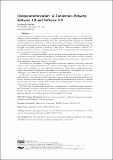| dc.contributor.author | Carbin, Michael James | |
| dc.date.accessioned | 2021-03-02T16:06:43Z | |
| dc.date.available | 2021-03-02T16:06:43Z | |
| dc.date.issued | 2019-05 | |
| dc.identifier.isbn | 9783959771139 | |
| dc.identifier.issn | 1868-8969 | |
| dc.identifier.uri | https://hdl.handle.net/1721.1/130046 | |
| dc.description.abstract | A new ecosystem of machine-learning driven applications, titled Software 2.0, has arisen that integrates neural networks into a variety of computational tasks. Such applications include image recognition, natural language processing, and other traditional machine learning tasks. However, these techniques have also grown to include other structured domains, such as program analysis and program optimization for which novel, domain-specific insights mate with model design. In this paper, we connect the world of Software 2.0 with that of traditional software – Software 1.0 –through overparameterization: a program may provide more computational capacity and precision than is necessary for the task at hand. In Software 2.0, overparamterization – when a machine learning model has more parameters than datapoints in the dataset – arises as a contemporary understanding of the ability for modern, gradient-based learning methods to learn models over complex datasets with high-accuracy. Specifically, the more parameters a model has, the better it learns. In Software 1.0, the results of the approximate computing community show that traditional software is also overparameterized in that software often simply computes results that are more precise than is required by the user. Approximate computing exploits this overparameterization to improve performance by eliminating unnecessary, excess computation. For example, one – of many techniques – is to reduce the precision of arithmetic in the application. In this paper, we argue that the gap between available precision and that that is required for either Software 1.0 or Software 2.0 is a fundamental aspect of software design that illustrates the balance between software designed for general-purposes and domain-adapted solutions. A general-purpose solution is easier to develop and maintain versus a domain-adapted solution. However, that ease comes at the expense of performance. We show that the approximate computing community and the machine learning community have developed overlapping techniques to improve performance by reducing overparameterization. We also show that because of these shared techniques, questions, concerns, and answers on how to construct software can translate from one software variant to the other. | en_US |
| dc.description.sponsorship | United States. Office of Naval Research (Grant ONR N00014-17-1-2699) | en_US |
| dc.description.sponsorship | National Science Foundation (U.S.) (Grant NSF CCF-1751011) | en_US |
| dc.language.iso | en | |
| dc.publisher | Schloss Dagstuhl, Leibniz Center for Informatics | en_US |
| dc.relation.isversionof | 10.4230/LIPIcs.SNAPL.2019.1 | en_US |
| dc.rights | Creative Commons Attribution 4.0 International license | en_US |
| dc.rights.uri | https://creativecommons.org/licenses/by/4.0/ | en_US |
| dc.source | DROPS | en_US |
| dc.title | Overparameterization: A connection between software 1.0 and software 2.0 | en_US |
| dc.type | Article | en_US |
| dc.identifier.citation | Carbin, Michael. “Overparameterization: A connection between software 1.0 and software 2.0.” Paper in Leibniz International Proceedings in Informatics, LIPIcs, 136, 3rd Summit on Advances in Programming Languages (SNAPL 2019), Providence, RI, May 16-17, 2019, Schloss Dagstuhl, Leibniz Center for Informatics: 1-13 © 2019 The Author | en_US |
| dc.contributor.department | Massachusetts Institute of Technology. Computer Science and Artificial Intelligence Laboratory | en_US |
| dc.relation.journal | Leibniz International Proceedings in Informatics, LIPIcs | en_US |
| dc.eprint.version | Final published version | en_US |
| dc.type.uri | http://purl.org/eprint/type/JournalArticle | en_US |
| eprint.status | http://purl.org/eprint/status/PeerReviewed | en_US |
| dc.date.updated | 2020-12-04T16:58:25Z | |
| dspace.orderedauthors | Carbin, M | en_US |
| dspace.date.submission | 2020-12-04T16:58:27Z | |
| mit.journal.volume | 136 | en_US |
| mit.license | PUBLISHER_CC | |
| mit.metadata.status | Complete | |
